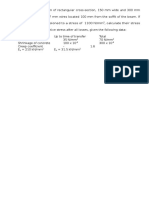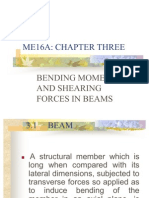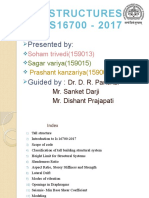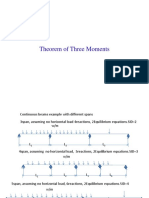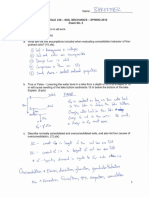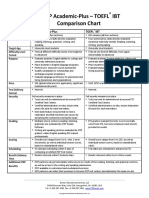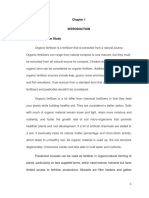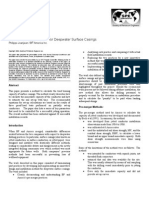Seismic & Wind Analysis of Bridges
Seismic & Wind Analysis of Bridges
Uploaded by
Abera MamoCopyright:
Available Formats
Seismic & Wind Analysis of Bridges
Seismic & Wind Analysis of Bridges
Uploaded by
Abera MamoCopyright
Available Formats
Share this document
Did you find this document useful?
Is this content inappropriate?
Copyright:
Available Formats
Seismic & Wind Analysis of Bridges
Seismic & Wind Analysis of Bridges
Uploaded by
Abera MamoCopyright:
Available Formats
SEISMIC & WIND ANALYSIS OF BRIDGES
Based on Recommended LRFD guidelines for
Seismic design on Highway bridges (May 2006 ed.)
WIND ANALYSIS OF BRIDGES
Pressure specified shall be assumed to be caused by a base design wind velocity
VB = 160 Km/hr.
For bridges or parts of bridges more than 10,000 mm above low ground or water
level, design wind velocity VDZ should be adjusted according to:
Where VDZ = Design wind velocity at elevation Z (Km/hr) V10 = Wind velocity at 10 000 mm above low ground or design water level (Km/hr) VB = Base wind velocity of 160 Km/hr at 10 000 mm height Z = Height of structure at which wind loads are being calculated as measured from low ground or water level > 10 000 mm V0 = Friction velocity a meteorological wind characteristic taken as specified in Table below Z0 = Friction length of upstream fetch a meteorological wind characteristic taken as specified in Table below. V10 may be established from basic wind speed charts available for various recurrence intervals, site specific wind surveys or in absence of better criteria, the assumption that V10 = VB = 160 Km/hr
WIND ANALYSIS OF BRIDGES
WIND PRESSURE ON STRUCTURES
The total wind loading shall not be taken less than 4.4 N/mm in the plane of windward chord and 2.2 N/mm in the plane of leeward chord of truss or arch components and not less than 4..4 N/mm on beam and girder spans.
WIND ANALYSIS OF BRIDGES
LOADS FROM SUPERSTRUCTURES
Where wind is not taken as normal to the structure, the base wind pressures PB
for various angles of wind direction may be taken as specified in table below and shall be applied to the single place of exposed area. The skew angle shall be taken as measured from perpendicular to the longitudinal axis. The wind direction for design shall be that which produces the extreme force effect on the component under investigation.
The transverse and longitudinal pressures shall be applied simultaneously.
WIND ANALYSIS OF BRIDGES
FORCES APPLIED DIRECTLY TO THE
SUBSTRUCTURE
The transverse and longitudinal forces to be applied directly to the substructure shall be calculated from an assumed base wind pressure of 0.0019 MPa. For wind direction taken skewed to the substructure, this force shall be resolved into components perpendicular to the end and front elevations of the substructure. The component perpendicular to the end elevation shall act on exposed substructure area as seen in end elevation, and the component perpendicular to the front elevation shall act on the exposed areas and shall be applied simultaneously with the wind loads from superstructure.
WIND PRESSURES ON VEHICLES
When vehicles are present the design pressure should be applied on both structure and vehicles. Wind pressure on vehicles shall be represented by an interruptible moving force of 1.46 N/mm acting normal to and 1800 mm above the roadway and shall be transmitted to the structure. When wind on vehicles is not taken as normal to the structure, the components of normal and parallel force applied to the live load may be taken as specified in the table below
WIND ANALYSIS OF BRIDGES
Example: WIND ANALYSIS
SEISMIC ANALYSIS OF BRIDGES
IMPORTANCE CATEGORIES
1. Critical bridges (open to all vehicles immediately after EQ. 2500 year return period)
2. Essential bridges (open to emergency / defense / security vehicles immediately after EQ. 475 year return period event) 3. Other bridges
SEISMIC PERFORMANCE ZONE
SEISMIC ANALYSIS OF BRIDGES
SOIL PROFILE TYPE
SOIL PROFILE I: Rock either shale or crystalline in nature. SOIL PROFILE II: Stiff cohesive or deep cohesion less soil. SOIL PROFILE III: Soft to medium stiff clay and sand. SOIL PROFILE IV: Soft clay or silt.
ELASTIC SEISMIC RESPONSE COEFFICIENT
SEISMIC ANALYSIS OF BRIDGES
For bridges on Soil profile III & IV & in areas where A is not less than 0.3, Csm need not exceed 2.0 A. For soil profiles III & IV and for modes other than fundamental mode that have period less than 0.3 s, Csm shall be taken as
If period of vibration for any mode exceeds 4.0 s the value of Csm for that mode shall be taken as
SEISMIC ANALYSIS OF BRIDGES
As per AASHTO LRFD Bridges in seismic
zone 1 need not be analyzed for seismic loads regardless of their importance and geometry. However the minimum requirements in sections 4.7.4.4 & 3.10.9 shall be applied. Seismic analysis for is not required for single span bridges, regardless of the seismic zone.
SEISMIC ANALYSIS OF BRIDGES
Seismic analysis required / not required
* = No seismic analysis is required UL = Uniform load elastic method SM = Single mode elastic method MM = Multimode elastic method TH = Time history method
SEISMIC ANALYSIS OF BRIDGES
Regular & Irregular bridges
Bridges satisfying the above table requirements may be regarded as Regular bridges otherwise Irregular bridges. Curved bridges comprise of multi simplespan shall be considered as irregular bridge if subtended angle in plan is greater than 20o. Such bridges shall be analyzed by either multimode elastic method or time history method.
SEISMIC ANALYSIS OF BRIDGES
A curved continuous girder bridge may be analyzed as if it were straight, provided all of the following requirements are meet. 1. The bridge is regular as defined in table above except that for a two span bridge the maximum span length ratio from span to span must not exceed 2. 2. The subtended angle in plan is not greater than 90 deg. 3. The span lengths of the equivalent straight bridge are equal to the arc lengths of the curved bridge. If the requirements are not satisfied then the curved continuous girder-bridge must be analyzed using the actual curved geometry.
SEISMIC ANALYSIS OF BRIDGES
Where Po = uniform load arbitrarily set = 1 (N/mm) Vs(x) = Deformation corresponding to Po (mm) W(x) nominal unfactored dead load of the bridge superstructure and tributary substructure (N/mm) Then calculate the time period of the bridge structure
g = Acceleration due to gravity (m/sec2)
You might also like
- C1 Assignment1 Due by 01feb2021Document2 pagesC1 Assignment1 Due by 01feb2021JP de AzevedoNo ratings yet
- iTEP Academic Booklet PDFDocument16 pagesiTEP Academic Booklet PDFAbera Mamo67% (3)
- iTEP Preparation Guide 3rd Edition 22JUN12 PDFDocument92 pagesiTEP Preparation Guide 3rd Edition 22JUN12 PDFAbera Mamo89% (9)
- Chapter 2Document149 pagesChapter 2zelalemniguse75% (4)
- Philippine National Standard: Organic AgricultureDocument52 pagesPhilippine National Standard: Organic Agriculturemae montecillo80% (5)
- TRL447 (Updated)Document80 pagesTRL447 (Updated)kranthi13No ratings yet
- Karol Ghati Pile Calc 2Document2 pagesKarol Ghati Pile Calc 2Muhammad BilalNo ratings yet
- 4.0 - Thaddeus - Cheat Sheet PDFDocument4 pages4.0 - Thaddeus - Cheat Sheet PDFJoe ColomboNo ratings yet
- Mid Term Exam With Solutions PDFDocument15 pagesMid Term Exam With Solutions PDFAbera Mamo100% (5)
- Terms of Reference For Hotel BuildingDocument13 pagesTerms of Reference For Hotel BuildingTrilok Khanal100% (2)
- Utilization of Golden Snail As Alternative Liquid Organic Fertilizer Lof On Paddy Farmers in Dairi IndonesiaDocument5 pagesUtilization of Golden Snail As Alternative Liquid Organic Fertilizer Lof On Paddy Farmers in Dairi IndonesiaAlyssa AsuncionNo ratings yet
- Buckling 1-1 PDFDocument6 pagesBuckling 1-1 PDFFilip StojkovskiNo ratings yet
- Columns - Inelastic BucklingDocument1 pageColumns - Inelastic BucklingpaoloNo ratings yet
- Reinforced Concrete Structure (Column Design Based On EC2)Document13 pagesReinforced Concrete Structure (Column Design Based On EC2)tijaNo ratings yet
- Column BucklingDocument13 pagesColumn BucklingConnor Hoover0% (1)
- Buckling of ColumnsDocument47 pagesBuckling of ColumnsMuhamad Khairudin AwangNo ratings yet
- Arch DesignDocument16 pagesArch DesignATHULNo ratings yet
- 16 Mega Column and Highrise NewDocument32 pages16 Mega Column and Highrise Newgv bwNo ratings yet
- Eccentric Column BucklingDocument10 pagesEccentric Column BucklingMukeshChopraNo ratings yet
- Dynamic of Billboard Thin PlateDocument6 pagesDynamic of Billboard Thin PlateJoseph Cloyd LamberteNo ratings yet
- Column Buckling: (Centric Loaded)Document13 pagesColumn Buckling: (Centric Loaded)Muhammad sheryarNo ratings yet
- Buckling of ColumnsDocument35 pagesBuckling of ColumnsMuhammad HaziqNo ratings yet
- Buckling in ColumnsDocument8 pagesBuckling in ColumnsnirgaNo ratings yet
- Heathrow TowerDocument6 pagesHeathrow TowerRoel PlmrsNo ratings yet
- A Seismic Design of Concrete BridgesDocument25 pagesA Seismic Design of Concrete BridgesBesima BajrićNo ratings yet
- Column Buckling TestDocument8 pagesColumn Buckling TestWiy GuomNo ratings yet
- Pre StressDocument9 pagesPre StressKevin John Ordoña EstilloreNo ratings yet
- Comparative Response Assessment of Steel Frames With Different Bracing PDFDocument14 pagesComparative Response Assessment of Steel Frames With Different Bracing PDFaxl_calin82No ratings yet
- Stability & Buckling Module 9Document10 pagesStability & Buckling Module 9maran.suguNo ratings yet
- Natural Frequencies of A Tapered Cantilever Beam of Constant Thickness and Linearly Tapered WidthDocument9 pagesNatural Frequencies of A Tapered Cantilever Beam of Constant Thickness and Linearly Tapered WidthAleksandar Nikolic100% (1)
- 2-Equation For Stress-Strain Curve (Desayi, Et Al., 1978) PDFDocument7 pages2-Equation For Stress-Strain Curve (Desayi, Et Al., 1978) PDFJhe TaguinesNo ratings yet
- Prefab 2015R Question BankDocument7 pagesPrefab 2015R Question BankTara Chandra PanjiyarNo ratings yet
- RC Frame Building With Masonry Infill Walls Designed For Gravity LoadsDocument16 pagesRC Frame Building With Masonry Infill Walls Designed For Gravity LoadsFeras TemimiNo ratings yet
- Beams Subjected To Torsion and Bending - I: I + I + I) - Here IDocument18 pagesBeams Subjected To Torsion and Bending - I: I + I + I) - Here Isagar1503No ratings yet
- RC Design I ColumnsDocument32 pagesRC Design I Columnseph100% (1)
- Plastic Section Moduli For I.S. Rolled Steel Beam Sections Zpy About Y-Y AxisDocument8 pagesPlastic Section Moduli For I.S. Rolled Steel Beam Sections Zpy About Y-Y AxisIJRASETPublicationsNo ratings yet
- General Method For Lateral and Lateral Torsional Buckling of Structural Components in Eurocode 3Document12 pagesGeneral Method For Lateral and Lateral Torsional Buckling of Structural Components in Eurocode 3VivaCharlesNo ratings yet
- CE 431 Column Analogy MethodDocument11 pagesCE 431 Column Analogy MethodBoucharebKarimNo ratings yet
- Steel StructureDocument8 pagesSteel StructureﱞﱞﱞﱞﱞﱞﱞﱞﱞﱞﱞﱞﱞﱞﱞﱞﱞﱞﱞﱞﱞﱞﱞﱞNo ratings yet
- Materials Engineering: Pangasinan State University Urdaneta Campus Mechanical Engineering DepartmentDocument7 pagesMaterials Engineering: Pangasinan State University Urdaneta Campus Mechanical Engineering DepartmentiamjemahNo ratings yet
- Chapter 3 PDFDocument8 pagesChapter 3 PDFShazreel AmirNo ratings yet
- CIV6235 - Shear (MG)Document26 pagesCIV6235 - Shear (MG)friendycalls100% (1)
- Solved MDOF Example PDFDocument9 pagesSolved MDOF Example PDFhillamngNo ratings yet
- Prestressed Concrete StructuresDocument5 pagesPrestressed Concrete StructuresY SAHITHNo ratings yet
- PPT-SF BM 1Document68 pagesPPT-SF BM 1Sudhir PatelNo ratings yet
- Buckling of ColumnsDocument41 pagesBuckling of Columnsassi_thaer100% (2)
- Chapter One: Structural Design (Introduction, Materials and Design Concepts)Document61 pagesChapter One: Structural Design (Introduction, Materials and Design Concepts)Boopathi YoganathanNo ratings yet
- Concrete Column Design PDFDocument2 pagesConcrete Column Design PDFengr.thoybitz.ce913No ratings yet
- A Seismic Design of Concrete BridgesDocument25 pagesA Seismic Design of Concrete Bridgesnepoznati1111No ratings yet
- Continuous T BeamDocument27 pagesContinuous T BeamMar Martillano100% (1)
- DOS Tall Building FinalDocument50 pagesDOS Tall Building Finalsoham trivediNo ratings yet
- Mechanics of Structures Vol IIDocument3 pagesMechanics of Structures Vol IIAkshay RaskarNo ratings yet
- 3.1.1 About Strut-and-Tie MethodDocument14 pages3.1.1 About Strut-and-Tie MethodChee Fong MakeNo ratings yet
- Theorem of Three Moments Modified PDFDocument10 pagesTheorem of Three Moments Modified PDFMahaveer DhakadNo ratings yet
- Bill Mosley John Bungey & Ray Hulse: Reinforced Concrete Design To EC2Document36 pagesBill Mosley John Bungey & Ray Hulse: Reinforced Concrete Design To EC2RyanWongJiaHanNo ratings yet
- Design of RCC ColumnsDocument8 pagesDesign of RCC Columnshitendra_gkNo ratings yet
- Response Spectrum Analysis of Girder Bridges With Seismic Isolators Using Effective StiffnessDocument10 pagesResponse Spectrum Analysis of Girder Bridges With Seismic Isolators Using Effective StiffnessJózsef SimonNo ratings yet
- Structural Dynamics in Bulding CodesDocument63 pagesStructural Dynamics in Bulding CodesThomas ClarkNo ratings yet
- Plaxis 2DDocument13 pagesPlaxis 2DVo Dinh ThaoNo ratings yet
- BNBC - 2017 Part6 - Chap 2 PDFDocument118 pagesBNBC - 2017 Part6 - Chap 2 PDFPioneer Design and Development Limited0% (1)
- Buckling of ColumnsDocument20 pagesBuckling of ColumnsOleNo ratings yet
- 1 Deflection Diagrams and The Elastic Curve 1Document35 pages1 Deflection Diagrams and The Elastic Curve 1DarwinNo ratings yet
- W 6Document26 pagesW 6FanooNo ratings yet
- Design of Steel Truss Roof StructureDocument22 pagesDesign of Steel Truss Roof StructureV.m. Rajan100% (2)
- Bridge Analysis & Design ProcedureDocument6 pagesBridge Analysis & Design ProcedurePrakash Singh Rawal80% (5)
- OHE Mast - Bridges - PDFDocument37 pagesOHE Mast - Bridges - PDFMadhurimaMitra70% (10)
- GEOTECNICAL Depth-Set-1-Sample PDFDocument7 pagesGEOTECNICAL Depth-Set-1-Sample PDFAbera Mamo0% (1)
- 2016 Construction ManagmentDocument91 pages2016 Construction ManagmentAbera MamoNo ratings yet
- Ce2071 - Repair and Rehablitation of Structures (For Viii - Semester)Document15 pagesCe2071 - Repair and Rehablitation of Structures (For Viii - Semester)Abera MamoNo ratings yet
- Ce 2071 - Repair and Rehablitation of Structures (For Viii - Semester)Document15 pagesCe 2071 - Repair and Rehablitation of Structures (For Viii - Semester)Abera MamoNo ratings yet
- 1.201 Introduction To Transportation SystemsDocument14 pages1.201 Introduction To Transportation SystemsAbera MamoNo ratings yet
- CivE381MidSample PDFDocument27 pagesCivE381MidSample PDFAbera Mamo100% (1)
- 2005 Final PDFDocument8 pages2005 Final PDFAbera Mamo100% (1)
- 2013 Soil Mechanics II and Exercises Midterm Exam: e With Respect To The Initial Void Ratio. For This GroundDocument7 pages2013 Soil Mechanics II and Exercises Midterm Exam: e With Respect To The Initial Void Ratio. For This GroundAbera MamoNo ratings yet
- Soil Mechanics FinalDocument9 pagesSoil Mechanics Finalalijahromi94100% (1)
- Itepcom PDFDocument1 pageItepcom PDFAbera MamoNo ratings yet
- iTEP Academic Plus Vs TOEFL IBT Comparison Chart PDFDocument1 pageiTEP Academic Plus Vs TOEFL IBT Comparison Chart PDFAbera MamoNo ratings yet
- 1iTEPPreparationGuide PDFDocument84 pages1iTEPPreparationGuide PDFAbera MamoNo ratings yet
- ITEP Handbook Spring 2011Document49 pagesITEP Handbook Spring 2011Abera MamoNo ratings yet
- BH 2Document2 pagesBH 2dimas redindaNo ratings yet
- A Review of Lablab PurpureusDocument16 pagesA Review of Lablab PurpureusAdilah RoddiNo ratings yet
- Bashirr BaleeeDocument42 pagesBashirr BaleeeTesfaye DegefaNo ratings yet
- In Situ Stresses - Geostatic StressesDocument6 pagesIn Situ Stresses - Geostatic Stressesthenoob012345No ratings yet
- Grade 12 Bio Systems Technology Syllabus 619f326177b99Document41 pagesGrade 12 Bio Systems Technology Syllabus 619f326177b99weerasuriya subhashiNo ratings yet
- A Case Study of Bioremediation of Petroleum-Hydrocarbon Contaminated Soil at Crude Oil Spill SiteDocument16 pagesA Case Study of Bioremediation of Petroleum-Hydrocarbon Contaminated Soil at Crude Oil Spill Siterafiqqais100% (2)
- Science Workbook 4thDocument35 pagesScience Workbook 4thJocelynNo ratings yet
- Civil Engineering Mini Project-Flexible PavemetDocument31 pagesCivil Engineering Mini Project-Flexible PavemetG J R Ravikiran67% (9)
- Literature Review of Solid Waste Management PDFDocument5 pagesLiterature Review of Solid Waste Management PDFgw163ckjNo ratings yet
- Research PaperDocument14 pagesResearch Paperイブ アリエスNo ratings yet
- Geotechnical Laboratory: Open-Ended LabDocument1 pageGeotechnical Laboratory: Open-Ended LabSerinaaNo ratings yet
- Horison&MorfologiDocument53 pagesHorison&MorfologiNur Safira FirdausNo ratings yet
- CSE 521 Lecture 6Document14 pagesCSE 521 Lecture 6Clara KeruboNo ratings yet
- Sgo - Si - No. 10 Ang Mo Kio Industrial Park 2, Singapore 569501Document166 pagesSgo - Si - No. 10 Ang Mo Kio Industrial Park 2, Singapore 569501Jing LiNo ratings yet
- 4 P Polution DR JenanDocument82 pages4 P Polution DR JenanAbdullah EsmailNo ratings yet
- Spe 77357 MSDocument14 pagesSpe 77357 MSmohamedabbas_us3813No ratings yet
- Astm D 6913Document34 pagesAstm D 6913safak kahramanNo ratings yet
- Lecture 1 Crop ProductionDocument22 pagesLecture 1 Crop ProductionCharles AndevukuNo ratings yet
- QGT000516 PDFDocument10 pagesQGT000516 PDFtriple tripleNo ratings yet
- Material Report Packages 10Document28 pagesMaterial Report Packages 10Engineeri TadiyosNo ratings yet
- 1 Natural Resources Management B.sc. Final CurriculumDocument227 pages1 Natural Resources Management B.sc. Final CurriculumDani AmanuNo ratings yet
- Giammar-Thesis - Schoepite Dissolution - Similar To Uranates PDFDocument277 pagesGiammar-Thesis - Schoepite Dissolution - Similar To Uranates PDFWayne DingNo ratings yet
- CDI2MODULEDocument7 pagesCDI2MODULEPeach MaulionNo ratings yet
- Case Report - Vegetable Gardens in Rural Schools and EnviromentalDocument9 pagesCase Report - Vegetable Gardens in Rural Schools and EnviromentalFabiana Franciski de oliveiraNo ratings yet
- EcosystemDocument71 pagesEcosystemjayprilv05No ratings yet


























